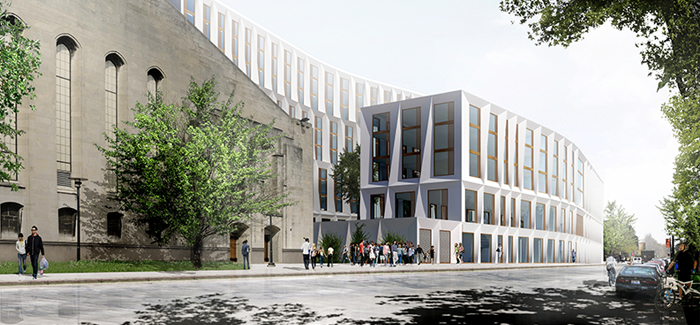
(Courtesy Studio Gang Architects)
Due north
A new dorm and dining commons on the site of Pierce Tower will remake 55th and University.
Before Pierce Tower’s demolition began in August the dorm’s loading dock lined 55th Street and University Avenue—and that might have been the corner’s most inviting feature. Architect Jeanne Gang’s design for the new Campus North Residence Hall and Dining Commons will eliminate what Chicago Tribune critic Blair Kamin called the “fortresslike street presence” in favor of something more like an open door.
A diagonal pathway accessible from that corner will “take students from the campus out to the city … and also invite the community into the campus,” Gang said. Retail along 55th Street will create an “urban, active edge” while a tree-lined sidewalk will add to University Avenue’s leafy character. “This corner,” Gang added, “becomes very important as this connection to Hyde Park.”
Gang and the University administrators who joined her at the July 23 unveiling emphasized the connections they hoped the design would create between the campus and the city, and among the 800 students—more than three times Pierce’s occupancy—who will live there. Three buildings of 15, 11, and five stories will make up the $148 million complex scheduled to open in 2016. The residence hall will have eight houses of about 100 first- through fourth-year students, each organized around three-story lounges.
Mixing students from different classes within a single house, said Karen Warren Coleman, vice president for campus life and student services, offers mentoring opportunities, another form of connective tissue built into the design. John W. Boyer, AM’69, PhD’75, dean of the College, referred to faculty committees dating back decades that argued for more, and more integrated, campus housing “to reflect the culture and the student milieu of the whole College, the whole University.”
In dorms of recent vintage, Max Palevsky and South Campus, Boyer said those aspirations have begun to be realized. “I think it will be even more the case in this great hall, to have all four years of the students living together in a multigenerational community.”
Input from students, Warren Coleman added, showed that third- and fourth-years covet independence even in campus housing. “They want to be able to cook together, they want to be able to go shopping and make their own meal,” she said. “So how could the University create spaces, create apartments, that allow them to stay on campus and still have the support of the College house system, but be able to have that kind of autonomy?” Private rooms with kitchen facilities will provide that for older students without their having to move off campus.
Architect Harry Weese’s ten-story Pierce Tower, built in 1960, suffered indignities including exploding toilets in recent years, but Gang found inspiration in its vitality. “The quality of the common areas, the places where students interact, really worked,” she said, noting that her design’s “cascading lounge” creates perches for people watching, a nod to elements she especially respected in Pierce.
She mentioned former residents who had visited to “say goodbye” to the building, but there was more anticipation than mourning. Boyer, in particular, expressed his enthusiasm for this tangible step toward his goal of keeping more undergraduates on campus. “A few years ago I had an opportunity to write a short history of student housing, basically making the case that we should build this dorm,” he said, “so it’s with some great appreciation that I find myself sitting here today next to our brilliant architect.”
Gang, the principal of Chicago’s Studio Gang Architects, received a 2011 MacArthur “genius” grant and a 2013 National Design Award. She joins Rafael Viñoly (Chicago Booth’s Harper Center), Helmut Jahn (Mansueto Library), and Tod Williams and Billie Tsien (Logan Center for the Arts) on the list of prominent architects who have altered the campus landscape in recent years. The Tribune’s Kamin called Gang’s residence hall and dining commons “the latest in a series of bold designs that have remade the storied, once-frumpy neo-Gothic enclave.”
